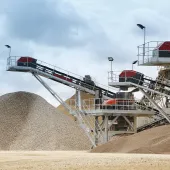
Latest Sustainable Development Report highlights the industry’s commitment to transparency
THE Mineral Products Association (MPA) has published its 2015 Sustainable Development (SD) Report, covering the year 2014.
The SD Report, which reiterates the mineral products industry’s commitment to quality reporting of evidence-based sustainability data to increase transparency, sets out the MPA’s priorities: a continued dedication to improving health and safety; the supply of sustainable products; a reduction in CO2 emissions from production; and support for conserving the natural environment.
The MPA says sustainable development initiatives for industry sectors can be particularly challenging, for example in relation to consistent data availability. However, this report demonstrates the commitment of the mineral products sector to be open and forthcoming with good information, highlights of which include:
- A range of initiatives implemented by the MPA to help progress on safety and increase focus on health issues.
- MPA members’ Lost Time Incident Frequency Rate (LTIFR) improved from 5.13 to 3.25, indicating a general improvement in operational health and safety.
- The MPA has continued to focus on improving vulnerable road user safety through the implementation of driver training and fitting additional vehicle safety equipment. A key development is the Construction Logistics and Cyclist Safety (CLOCS) initiative, designed to ensure a common standard for all parts of the construction industry.
- Rail freight movements of aggregates increased to 18.5 million tonnes in 2014, representing an 11.6% share of the market, and 20.4% of cement is delivered by rail.
- More than 90% of surveyed MPA materials sales were certified as Responsibly Sourced, highlighting the sustainable management of domestic supply chains, and a similar level of industry sites operated with certified environmental management systems.
- The use of recycled and secondary aggregates in domestic markets accounted for 29% of the total aggregates market, which is over three times as high as the European average.
- Data collection had so far identified nearly 6,000ha of priority habitat created by MPA members and a further 6,000ha planned for future delivery.
- In the marine environment, BMAPA members have been involved in the development of a network of Marine Protected Areas and BMAPA has co-ordinated a series of regional monitoring surveys which resulted in more than 3,500 seabed samples being collected – one of the largest sampling exercises ever undertaken on the UK Continental Shelf.
Commenting on the report, MPA chief executive Nigel Jackson said: ‘The MPA supports the industry’s continuing commitment to measuring and reporting data and to transparency on performance.
‘I am pleased that this 2015 report indicates that the sector is moving in the right direction. Improving environment and sustainability performance remains a key objective for the MPA, which we will continue to monitor, manage and review throughout 2016.’









